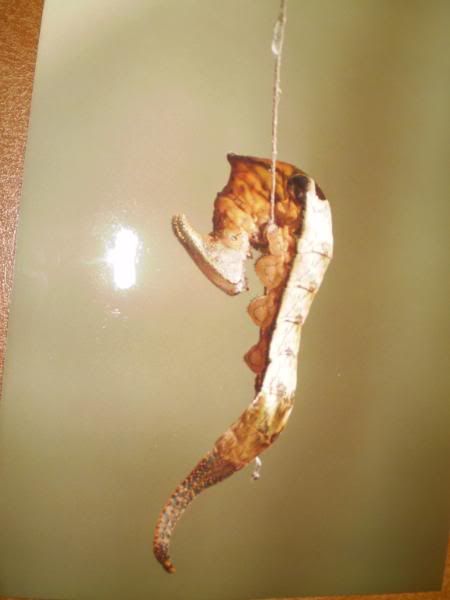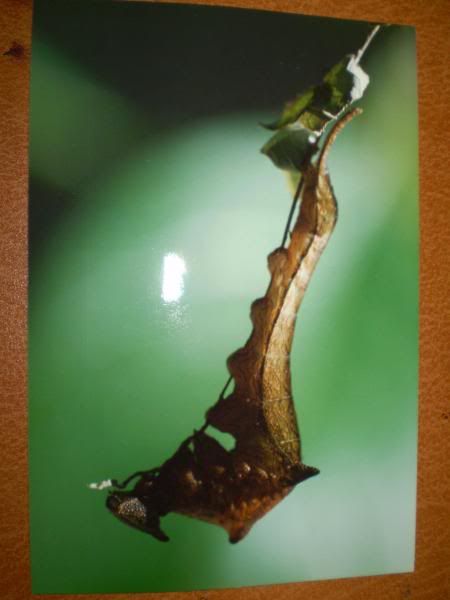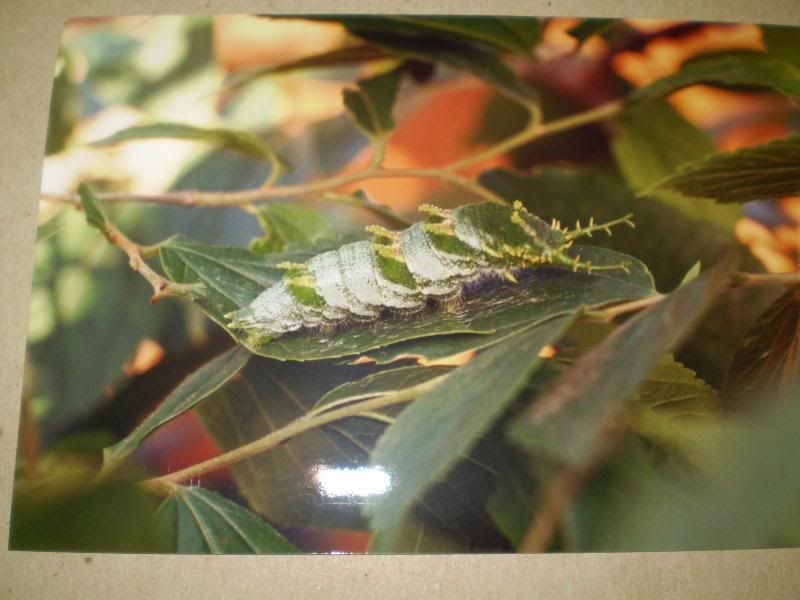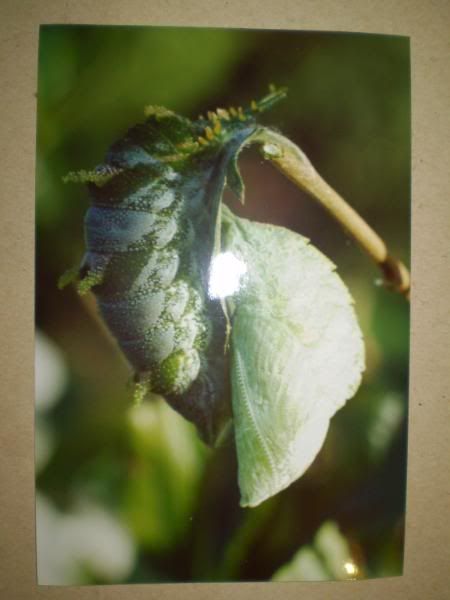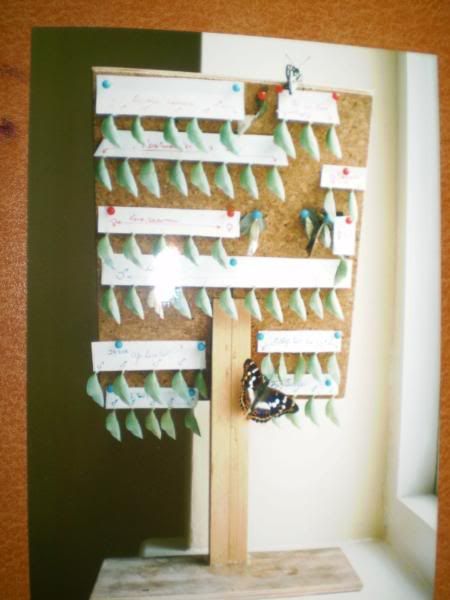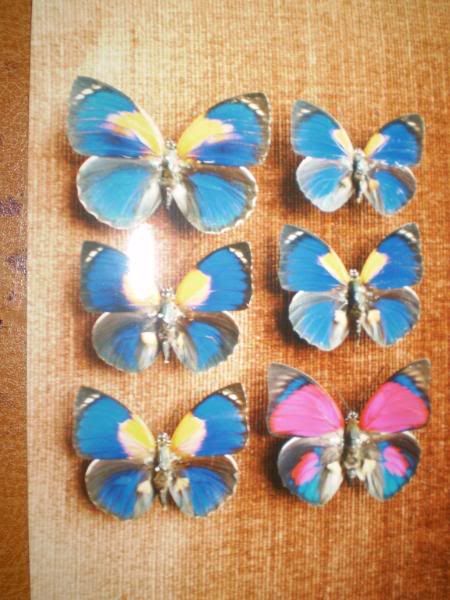I've been terminated ... May start breeding again..
Posted: Tue Jun 30, 2009 5:14 pm
Had official written confirmation that my current employers for the past eighteen years can no longer support my continuing part time employment.... hard times and all that. Cannot complain, I'm well past my sell by date.....  So lots of time on my hands for all sorts of things.
So lots of time on my hands for all sorts of things.
Clearing out my desk last week, I came across a long forgotten photo prints album compiled when I used to breed butterflies regularly. Here for those who may be interested are some of those images. Do please bear in mind that these are Digital Compact reproductions of 6 x 4 prints, mainly from the 1980s, some thirty years old so the quality has suffered somewhat but, they serve their purpose.
This first image shows a pair of Apatura iris in copula in one of my breeding cages. Maybe some of those who frequent this site maybe thinking that pair of butterflies should have been left in their English native broadleaved woodland habitats. But, they would be wrong, very wrong. Nothing could be further from the truth with the emphasis on further. This pair is in fact from the extreme eastern edge of our single Apaturinae species' range from South Korea. It is Apatura iris peninsularis. Identical to our own species but, to my eyes, often a tad larger and there is usually a fine mauve tint to the underside of the Korean butterfles which I have never seen in our butterfly.
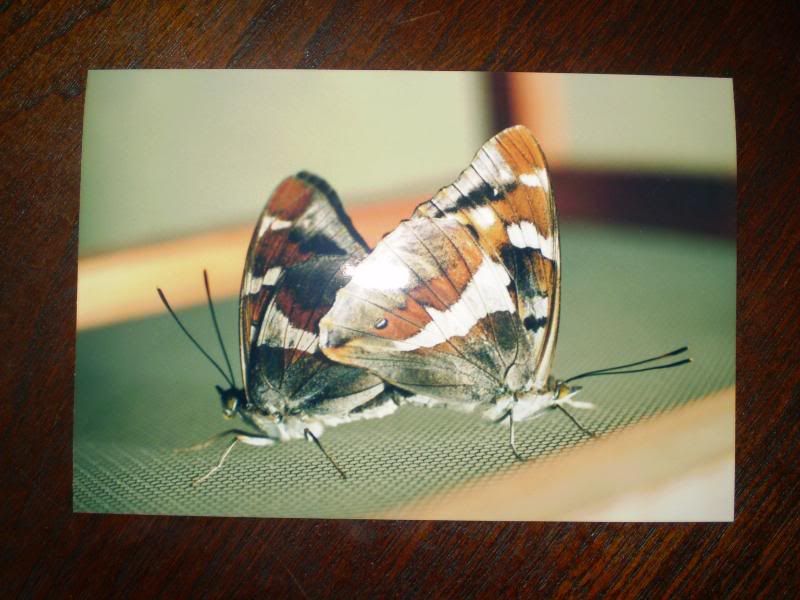
Over the years, I have bred large numbers of about twenty Apaturinae/Preponini species in my cages, sometimes so successfully that sheer numbers can cause problems. For example, how to provide five hundred natural winter hibernation sites for Purple Emperor larvae. It can lead to problems but, I managed as I prepared with ample growing foodplant. Even so, ideal locations can be at a premium and leads to overcrowding.. as in this composite picture of three separate prints:~
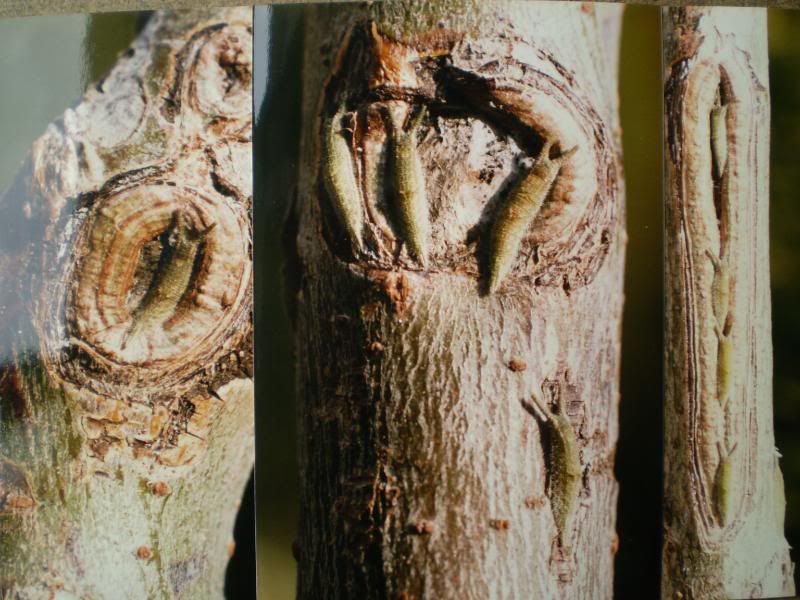
Also, with continued further generations in mind, pupae management needs to be coordinated ~ these are the Korean race of A.iris :~
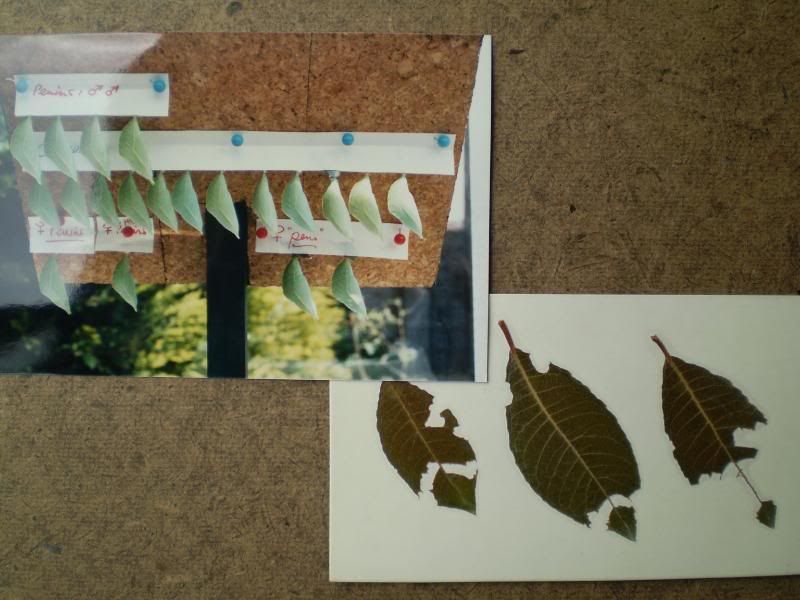
The leaf specimens on the card I used to pass around the audience when giving slide-talk shows to interested groups years ago. shows what to look for so, if you find something like this in late summer, early autumn on the Salix species ( Sallows) in your local woods, then consider yourself lucky... I discovered a few 'new' woods with this butterfly simply by looking for these tell tale signs on the leaves after the flight season.
I discovered a few 'new' woods with this butterfly simply by looking for these tell tale signs on the leaves after the flight season.
I've used similar captive breeding techniques for other members of this fabulous butterfly family. Here's the female and life history of one of my favourites :~ Chitoria ( previously Apatura) ulupi. The sexes are strongly dimorphic as can be seen in the picture of the paired couple. The upperside of the female is similar to our own butterfly, the male completely different although I'm informed, some males resemble the female's upperside but, I've never seen that form in my breeding cages and I've bred a good number. The larval foodplant is Celtis, not a native UK species but, a member of the Elms. First the female underside :~
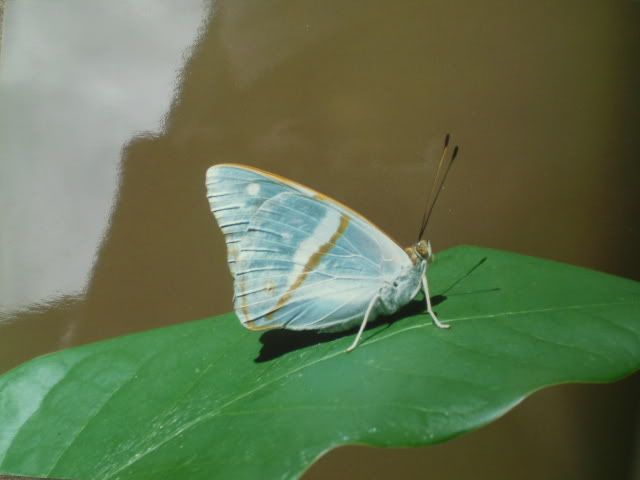
The pairing :~
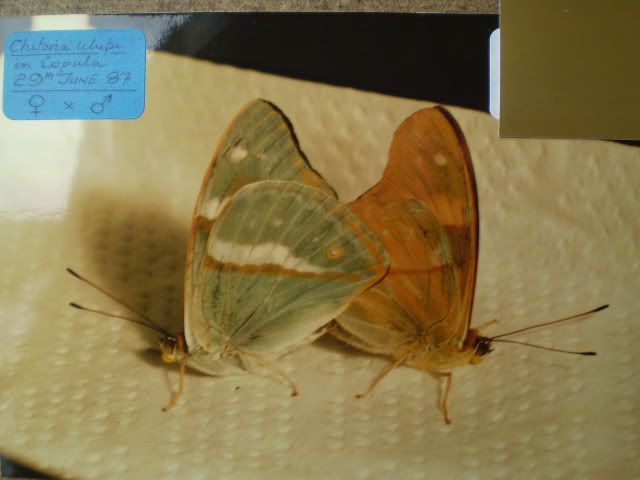
Egg batch and 1st instar larvae :~
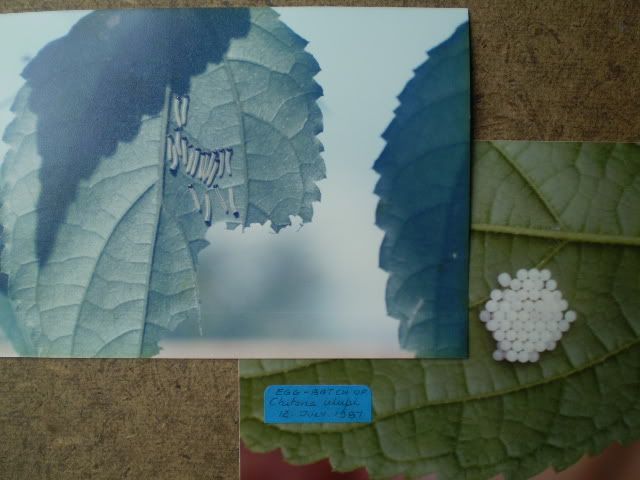
Fully grown larva and pupa :~
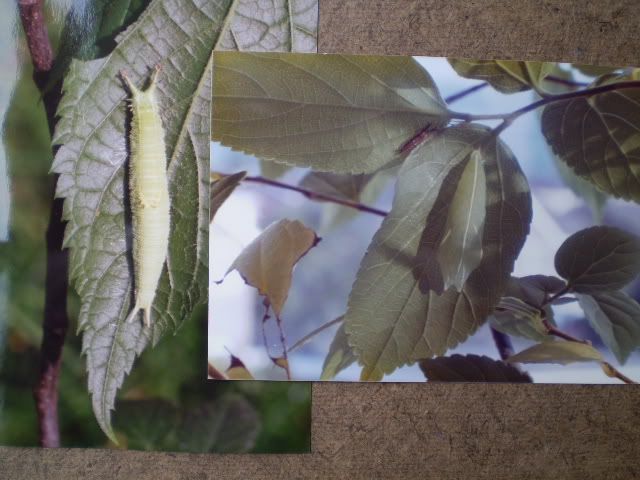
Look carefully to the upper left of that suspended pupa. There you will see a small larva about to enter hibernation ~ note its colouring. Actually, this picture was taken in Autumn and the pupa is a rare 2nd brood example ~ all the other larve did the sensible thing and settled down to successful hibernation. The Oriental winter can be harsher than ours....
Some of the other species bred include the Camberwell Beauty and Lesser Purple Emperor ( Apatura ilia ). The two 1st instar larvae are on one of my growing Aspen saplings. The honey coloured egg batch of N.antiopa are as they appear when freshly laid, if fertile, they colour up a week or two later when the black heads of the tiny larvae can be seen through the egg shells.... Those eggs are on one of my potted sallows used for the PEs...
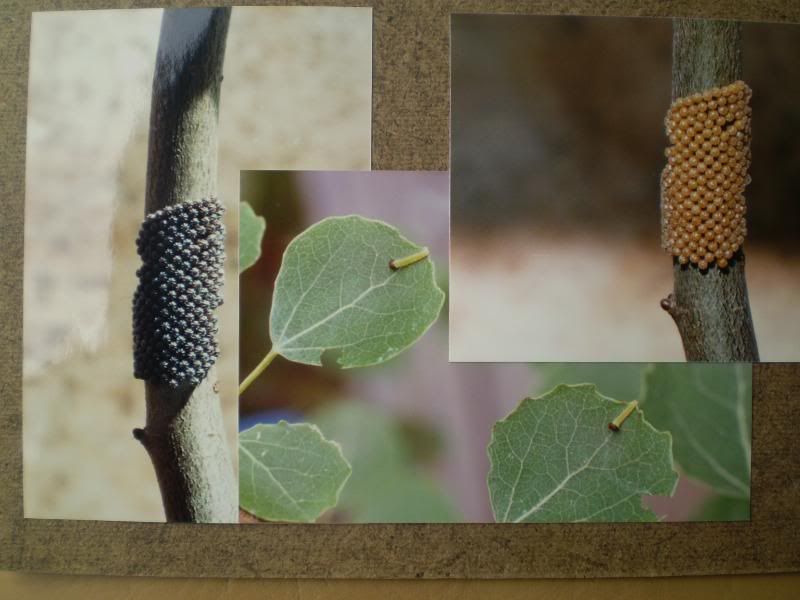
Finally, here is another composite picture of my very favourite European and South American butterflies .... The Poplar Admiral ( also reared on the same Aspens as A.ilia ) and a representative of my all time favourite Butterfly families, the Prepona and Agrias. Thirty years ago, I grew an Avvocado plant from the large seed stone. Within a couple of years it became a fine, atractive two metre high plant which my wife wanted as an ornamental house plant ~ no chance ~ it was reserved for my beautiful Preponas ~ they, for those who are not familiar with them, are large, powerful butterflies not too far unrelated to our own Purple Emperor.... They too have a black upper wing surface with rich irridescent blue or purple bands... fabulous. The closely related Agrias sp.are even more breathtakingly beautiful. I have also obtained fertile pairings of Prepona in capativity.... I still have one ambition... to breed some Agrias. I even obtained some seeds of their foodplant... then discovered that the foodplant is the very same as that the drug Cocaine is obtained from.... DOH! You need a licence to grow that ~ difficult to grow in the UK anyway... shame...
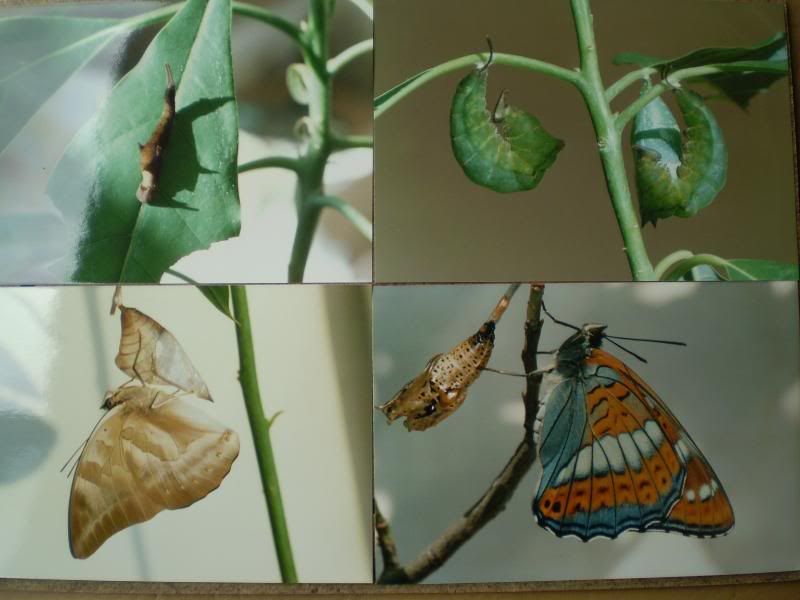
Did I mention I've also bred fine Morpho species ~ those huge beauties with breathtaking irridescent blue upper wings ? ... on of all things peanuts ..yes, not the actual nuts..... .... , but the plants you can grow from the nuts..... got pictures of their life history too ...
.... , but the plants you can grow from the nuts..... got pictures of their life history too ...
All this is now ancient history for me but, if there's sufficient interest in my ancient butterfly breeding activities, I'll get those old albums down from the loft... there's lots...
..
Clearing out my desk last week, I came across a long forgotten photo prints album compiled when I used to breed butterflies regularly. Here for those who may be interested are some of those images. Do please bear in mind that these are Digital Compact reproductions of 6 x 4 prints, mainly from the 1980s, some thirty years old so the quality has suffered somewhat but, they serve their purpose.
This first image shows a pair of Apatura iris in copula in one of my breeding cages. Maybe some of those who frequent this site maybe thinking that pair of butterflies should have been left in their English native broadleaved woodland habitats. But, they would be wrong, very wrong. Nothing could be further from the truth with the emphasis on further. This pair is in fact from the extreme eastern edge of our single Apaturinae species' range from South Korea. It is Apatura iris peninsularis. Identical to our own species but, to my eyes, often a tad larger and there is usually a fine mauve tint to the underside of the Korean butterfles which I have never seen in our butterfly.

Over the years, I have bred large numbers of about twenty Apaturinae/Preponini species in my cages, sometimes so successfully that sheer numbers can cause problems. For example, how to provide five hundred natural winter hibernation sites for Purple Emperor larvae. It can lead to problems but, I managed as I prepared with ample growing foodplant. Even so, ideal locations can be at a premium and leads to overcrowding.. as in this composite picture of three separate prints:~

Also, with continued further generations in mind, pupae management needs to be coordinated ~ these are the Korean race of A.iris :~

The leaf specimens on the card I used to pass around the audience when giving slide-talk shows to interested groups years ago. shows what to look for so, if you find something like this in late summer, early autumn on the Salix species ( Sallows) in your local woods, then consider yourself lucky...
I've used similar captive breeding techniques for other members of this fabulous butterfly family. Here's the female and life history of one of my favourites :~ Chitoria ( previously Apatura) ulupi. The sexes are strongly dimorphic as can be seen in the picture of the paired couple. The upperside of the female is similar to our own butterfly, the male completely different although I'm informed, some males resemble the female's upperside but, I've never seen that form in my breeding cages and I've bred a good number. The larval foodplant is Celtis, not a native UK species but, a member of the Elms. First the female underside :~

The pairing :~

Egg batch and 1st instar larvae :~

Fully grown larva and pupa :~

Look carefully to the upper left of that suspended pupa. There you will see a small larva about to enter hibernation ~ note its colouring. Actually, this picture was taken in Autumn and the pupa is a rare 2nd brood example ~ all the other larve did the sensible thing and settled down to successful hibernation. The Oriental winter can be harsher than ours....
Some of the other species bred include the Camberwell Beauty and Lesser Purple Emperor ( Apatura ilia ). The two 1st instar larvae are on one of my growing Aspen saplings. The honey coloured egg batch of N.antiopa are as they appear when freshly laid, if fertile, they colour up a week or two later when the black heads of the tiny larvae can be seen through the egg shells.... Those eggs are on one of my potted sallows used for the PEs...

Finally, here is another composite picture of my very favourite European and South American butterflies .... The Poplar Admiral ( also reared on the same Aspens as A.ilia ) and a representative of my all time favourite Butterfly families, the Prepona and Agrias. Thirty years ago, I grew an Avvocado plant from the large seed stone. Within a couple of years it became a fine, atractive two metre high plant which my wife wanted as an ornamental house plant ~ no chance ~ it was reserved for my beautiful Preponas ~ they, for those who are not familiar with them, are large, powerful butterflies not too far unrelated to our own Purple Emperor.... They too have a black upper wing surface with rich irridescent blue or purple bands... fabulous. The closely related Agrias sp.are even more breathtakingly beautiful. I have also obtained fertile pairings of Prepona in capativity.... I still have one ambition... to breed some Agrias. I even obtained some seeds of their foodplant... then discovered that the foodplant is the very same as that the drug Cocaine is obtained from.... DOH! You need a licence to grow that ~ difficult to grow in the UK anyway... shame...

Did I mention I've also bred fine Morpho species ~ those huge beauties with breathtaking irridescent blue upper wings ? ... on of all things peanuts ..yes, not the actual nuts.....
All this is now ancient history for me but, if there's sufficient interest in my ancient butterfly breeding activities, I'll get those old albums down from the loft... there's lots...
..


